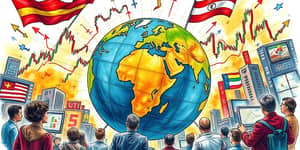
Education is more than a classroom experience; it is the foundation upon which societies build prosperity and well-being. As the world grapples with rapid changes, reforming education becomes an urgent necessity to unlock human potential and drive sustainable development.
Today’s educational landscape stands at a crossroads, shaped by demographic shifts, economic pressures, and digital transformation. Across continents, governments and institutions recognize that education as a driver for personal growth and societal progress demands new thinking. The global education market is on track to soar to nearly $10 trillion by 2030, underscoring the massive investments pouring into learning at all levels.
Amid this surge, stakeholders must balance scale with quality, ensuring that expanding access does not dilute the value of learning. To guide this journey, key indicators offer insight into emerging priorities.
The integration of technology and artificial intelligence in education has accelerated exponentially. In the last five years, searches for “AI in education” have grown twenty-fold, reflecting educators’ and learners’ thirst for innovation. AI now serves as a co-pilot in the classroom, offering personalized pathways, automated grading, and real-time feedback.
Adaptive learning platforms harness machine learning to tailor content to each student’s pace and style. Meanwhile, AI-enabled tools increase accessibility for learners with disabilities by generating automatic transcripts and audio descriptions. These advances are not mere gadgets; they represent a fundamental shift toward personalized education that can close achievement gaps and enrich learning experiences.
Traditional, linear educational journeys are giving way to multifaceted routes that recognize both formal and experiential learning. Internships, collaborative projects, travel programs, and capstone experiences are gaining esteem alongside academic transcripts. Admission processes increasingly value curiosity, resilience, and real-world competencies over rigid checklists.
Microcredentials and stackable certificates empower learners to build tailored skill portfolios. As a result, universities and certification bodies are collaborating with industries to ensure graduates possess in-demand competencies aligned to market needs. This evolution reflects a broader acknowledgment that learning is lifelong, nonlinear, and deeply intertwined with professional growth.
In an era of automation and shifting labor demands, workforce alignment sits at the heart of education reform. Governments and businesses alike invest heavily in reskilling and upskilling initiatives to maintain national competitiveness. Nearly 14% of universities have already revamped curricula to prepare students for AI-driven roles, and that figure continues to rise.
Partnerships between academia and industry foster career-aligned programs and apprenticeships. These collaborations ensure that graduates enter the job market with robust portfolios and a clear understanding of workplace dynamics. By bridging the gap between theory and practice, education can deliver tangible returns on investment for learners and employers.
Inequality remains a persistent barrier to universal education. Geographic, economic, and social factors still limit opportunities for vulnerable populations. The COVID-19 pandemic laid bare these disparities, prompting renewed focus on mental health supports, community outreach, and innovative delivery models that can reach remote or underserved learners.
Well-being initiatives within schools address not only academic success but also emotional resilience. Educators deploy counseling services, peer support networks, and mindfulness programs to nurture holistic student growth. To tackle affordability challenges, policymakers are exploring sliding-scale tuition, targeted scholarships, and public-private funding partnerships.
Leadership upheaval has become a hallmark of higher education, with more than 20% turnover in top roles between 2022 and 2024. This volatility signals deeper transformations within academic institutions, from rethinking degree requirements to embracing flexible credit hours and modular credentials.
Policy innovation is equally dynamic. Governments are reallocating resources toward vocational training, career and technical education, and targeted K–12 reforms. Initiatives like school choice experiments and micro-school models—where groups of ten or fewer learners engage in highly individualized instruction—offer glimpses of what education systems might become.
To navigate the complex terrain of education reform, stakeholders should focus on several strategic themes that cut across contexts and cultures:
Global education reform is more than policy tweaks or technology rollouts. It is a profound commitment to nurturing human potential, equipping individuals with the skills and resilience to thrive in an unpredictable world. By placing human capital at the center of every strategy—embracing innovation, ensuring equity, and aligning with workforce needs—we can build education systems that empower learners and fortify societies.
The path ahead will require collaboration among governments, institutions, communities, and learners themselves. Yet the promise is clear: when we invest wisely in education, we invest in a future of shared prosperity, social justice, and boundless creativity.
References













